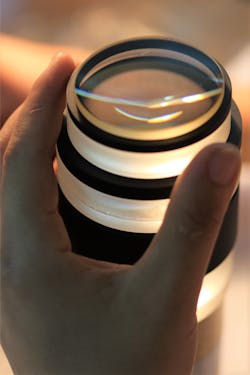Learning Optics with Austin: Lesson 7 – The Eyepiece and Lens Requirements
In the previous post, we looked at how changing the focal lengths produced different images (and virtual images) for SINGLE lenses. Sometimes, however, a system of lenses is needed to produce a desired image. A system is composed of two or more lenses assembled together. A good example of a system is the eyepiece of a microscope. While the name indicates that this is the part of the instrument viewed by the eye, the eyepiece itself is an assembled system containing multiple lenses inside.
Not all eyepieces are the same. In order to know what eyepiece a customer needs, an optics designer first needs to know what the customer wants. For example, if the customer wants a magnified image, then the designer should choose a convex lens as all concave lenses shrink the image. Convex and concave are not the only requirements in lens design though. The material the lens is made of can change the refractive index of the lens. Of course, the higher the refractive index, the costlier it is to manufacture the lens and thus, the more expensive the material.
Fused Silica is an expensive type of glass used to make this particular dome
Thickness is another requirement that will influence the price. As electronic devices such as the cell phone camera get smaller and smaller, so does the need for the lens to become smaller and smaller. Making a thin lens with the same properties as a thick lens is not easy, and so the thinner the lens, the higher the price of manufacturing.
The size of the container for these micro lenses is about the palm of a hand- the lenses are really tiny!
Coatings can also be added onto lenses in order to increase or decrease reflectivity. Normal glass lenses have a reflectivity around 4% and so if the reflectivity is to be changed, coatings are needed. Coatings of course, do not come without a cost and thus coating a lens will cost more than the same lens without coating.
High Speed Precision Grinding (video)
The smoothness of the lens affects the imaging precision. This is why a scratched up mirror does not produce as clear of an image as a polished mirror. Surface figure precision measures smoothness and a smoother surface requires more effort to create which is another factor that increases the price of the lens. In determining the type of material, thickness, coating, and surface figure precision of a lens, an increase in quality generally leads to an increase in price.
About the Author

Austin from Shanghai Optics Inc
Hello! My name is Austin and I am the host for this blog. I graduated from Rutgers in May 2021 with a Bachelor’s degree in Statistics-Mathematics and History. I interned during the summer of 2021 at Shanghai Optics working on data cleaning and analysis. I was later offered to work full-time starting in September. While my initial role was in data analytics, I realized that my knowledge of the company’s products was quite shallow as a key skill for any well-trained data analyst is to know your data. That’s how I got started on my journey in learning about optics.
I found physics interesting but challenging in high school. I did not particularly enjoy classical physics and a seminar in quantum mechanics flew over my head in college. As I see first-hand how our optics works in different applications, I’m quickly beginning to realize that Photonics has the potential to shape the present and the future. Because of my newfound enthusiasm, management took notice and I am fortunate enough to begin a Physics/Photonics class sponsored by Shanghai Optics in the fall of 2021. This blog is part of my experience in taking the class and sharing with you all the wealth of knowledge I’m acquiring!
Aside from optics, some of my personal interests include studying history and going on hikes. Both activities are great opportunities to talk with other people so feel free to ask me any questions on my personal interests or the materials I post!


